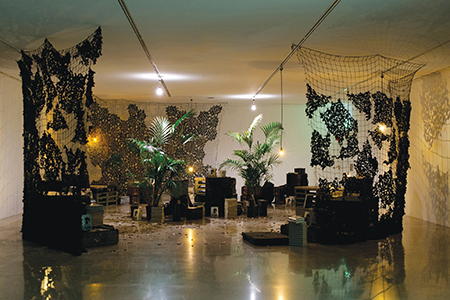David Lieske
mumok, Vienna, Austria
mumok, Vienna, Austria

Walking into David Lieske’s show ‘Platoon (RL-X)’ at Vienna’s Museum Moderner Kunst (mumok) was like stumbling onto a theatre set. Dim spotlights guided me toward a small, illuminated space in the centre of a huge, otherwise empty room. This area, reminiscent of an army camp set up in the clearing of a forest, was surrounded by camouflage netting and filled with sprouting palm plants, overturned crates and the muffled sound of crickets. The floor was strewn with bullet shells and piles of copies of a book: Lieske’s autobiography, entitled I Tried to Make This Work (2015).
German-born Lieske, who is also a musician and co-founder of the record label Dial, is no stranger to straddling artistic mediums. He proves his flexibility with ‘Platoon (RL-X)’ by creating a piece of literature that is as important as the carefully constructed, theatrical environment in which it is intended to be read. In fact, this surreal military space is the only setting in which Lieske’s autobiography is available, with all 300 copies of the book kept onsite in the mumok exhibition space.
As a book, I Tried to Make This Work is deeply ironic. Lieske self-consciously gives his memoirs a sense of artistic importance by dramatizing even the most ordinary moments in his life, stamping a constructed meaning onto inconsequential events and routines. The chapter entitled ‘Swimming Badge’ details his childhood swimming lessons, while the section called ‘Flute’ gives an account of Lieske’s instrument preferences. In between these banal accounts are pockets of sensationalism, where Lieske describes in intense, colourful detail his unrequited love, his first homosexual relationship and his infidelities. The first-person narrative makes us feel as if we are getting an honest insight into the artist’s psychology, but his over-sharing can be discomfiting. As I read Lieske’s description of his fetish for violence, the bullet shells on the floor and the paramilitary environment in which I found myself took on a disconcerting new significance. I became aware that a type of violence was being exerted upon me: if I wanted to read Lieske’s book, I was forced to do so in surroundings entirely dictated by the artist. Indeed, there is a distinct sense that Lieske enjoys exploiting the power dynamic between viewer and artist: the creation of a book that can only be read in the exhibition space demands far more time and attention than we might ordinarily give to a single artwork. The book may be neither well-written nor profound, but we’re compelled to read it, lured in by its confessions, sensationalism and the exclusivity of the experience. It’s as if Lieske relishes playing on our more instinctive human traits than our intellectual capabilities. When this realization dawned on me, I had an unpleasant feeling of having been tricked.
When I was there, the show’s space was full of people sitting on crates, reading. Visitors had unwittingly become part of a performance entitled ‘people experiencing art’. This is certainly an interesting conceptualization of the relationship a work of art has to its environment and viewers, but the exhibition is dominated by the persona of Lieske, who doesn’t come across as a particularly likeable figure. His narrative voice is self-absorbed and self-aggrandizing, and the constant references to his work, his contacts and his gallery seem steeped in arrogance. There’s no getting away from the sense that he has thoroughly enjoyed the process of making himself – rather than a more general notion of ‘the self’ – the centre of his work. In many ways, Lieske’s intense narcissism and self-reflexivity – whether ironic or unintentional – drowns out the show’s more nuanced subtexts.






















